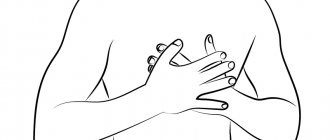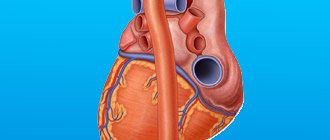The causes of chest deformation are divided into two groups - congenital and acquired. Deformity can be a consequence (complication) of a number of spinal diseases.
Among the main causes of deformation are the following:
- kyphosis,
- scoliosis,
- chronic obstructive pulmonary diseases,
- marfan syndrome,
- anomalies of osteogenesis,
- achondroplasia,
- Turner syndrome,
- Down Syndrome,
- emphysema,
- rickets,
- keeled deformity,
- funnel chest,
- cleft sternum,
- Poland syndrome,
- Wife Syndrome,
- congenital rib anomalies,
- asthma,
- incomplete fusion of the fetal sternum,
- congenital absence of the pectoral muscle,
- ankylosing spondylitis,
- inflammatory arthritis,
- osteomalacia
As we can see, in most cases, the deformity is caused by genetic reasons leading to abnormal development of the upper spine; it develops against the background of existing anomalies and syndromes.
Genetic causes, in turn, lead to the asymmetric development of bone and cartilage tissue and cause the development of asymmetry of the ribs and sternum, as a result - convexity or concavity of the chest.
Scoliosis, tuberculous bone infection, rickets, as well as all kinds of injuries and damage, including those associated with a person’s professional activity, are among the causes that cause acquired deformation of the chest.
Types of chest deformities
In children, two types of congenital pathology most often occur: funnel-shaped (also called “shoemaker’s breast”) and keeled:
- The funnel chest is characterized by a sunken shape of the front part, in which it is pressed inward and takes the form of a depression. In this case, the sternum visually appears expanded. Science does not know the exact reasons for the appearance of this defect.
- Keeled deformity appears already at birth and is expressed in the form of a convex shape of the bone corset of the chest. The cause of pectus carinatum is believed to be excessive growth of the ribs or osteochondral cartilage. Usually the disorder is accompanied by abnormal development of the spine, curvatures (scoliosis, kyphosis), and various types of heart defects. The keeled deformity can also be asymmetrical, with the shape of the sternum being sunken only on one side and protruding on the other.
Most experts agree that congenital chest deformity originates during intrauterine development. A child's rib cartilage grows too quickly, causing increased pressure, resulting in a sunken rib cage. The disease makes itself felt soon after the birth of the baby or in his first years of life. Associated syndromes may include rickets, abnormal development of the spine, heart disease, asymmetric development of bones and cartilage of the sternum. Over time, if left untreated, the deformity can rapidly progress, causing physiological discomfort and disturbances in the functioning of internal organs.
One of the most serious diseases is Poland syndrome. This is a rare congenital syndrome, which is characterized by a complete or partial absence of the muscular frame on one side and an accompanying malformation of the hand. Its cause is considered to be impaired blood circulation in the vertebral arteries during fetal development. In this case, the heart muscle and main arteries are not protected by the bone skeleton of the chest and are at risk of mechanical damage.
3. Symptoms, stages and diagnosis of funnel sternum
Already in the neonatal period, diagnosis of funnel chest is possible. The child’s chest is depressed, and during periods of crying, screaming, or taking a deep breath, the so-called “inhalation paradox” is observed - the depression of the ribs and sternum intensifies. It is noted that in 50% of cases this pathology disappears without a trace in the first months of life. In other children, the symptoms increase and may include:
- raised edges of the ribs and an enlarged abdomen;
- stridotic breathing with difficult wheezing inhalation;
- chronic pneumonia;
- thoracic kyphosis;
- flattened chest and drooping shoulders.
The funnel increases with development and can reach a volume of 200 cm3 in adults. Depending on its depth and accompanying disorders, three degrees of deformation are distinguished:
- Stage I (compensated) – the chest is deepened by 2 cm without displacement of the heart;
- Stage II (subcompensated) - the depth of the funnel is up to 4 cm, the heart is displaced by 2-4 cm;
- Stage III (decompensated) – a deeper depression in the sternum, combined with a pronounced displacement of the heart relative to the normal position.
Diagnosis of pectus excavatum is carried out by electromyographic study. During the study of anamnesis, visual examination and hardware examination methods, the following are revealed:
- structural changes in the respiratory muscles;
- decreased excursion of the chest and diaphragm, decreased vital capacity of the lungs;
- hypertrophy of the right ventricle of the heart;
- tissue hypoxia;
- general asthenia in children;
- retardation in physical development;
- vegetative-vascular dystonia;
- tendency to respiratory diseases, developing into bronchitis and pneumonia;
- cardiovascular and pulmonary failure.
About our clinic Chistye Prudy metro station Medintercom page!
Symptoms
The first symptom of chest deformation is external changes. The cosmetic defect may be barely noticeable in newborn babies: it can be detected when inhaling, and the ribs recede. As the child grows older, the disease becomes more pronounced and reaches its peak by 3 years.
A sunken chest in a child accounts for more than 90% of cases of the disease. With this pathology, the costal cartilages are not fully developed, the sternum is increased in width, the chest cavity is reduced, and curvature of the spine occurs. As a result of these processes, a child may lag behind his peers in physical development, often suffer from respiratory infections, suffer from autonomic disorders, and respiratory failure. Children react poorly to physical activity, get tired quickly and are not able to play sports on a par with their peers. If there is a disturbance in the upper or middle region, motor function also suffers.
Symptoms that occur during the development of pathology
In newborn babies, a funnel chest deformity can be expressed only as a small depression. Parents may not even pay attention to it, and only as they grow older can this pathology turn into a serious problem. The only thing that is observed in babies is the so-called “inhalation paradox”, when the chest sinks while the baby cries or screams. Fortunately, according to statistics, the inhalation paradox and sunken sternum disappear in the first month of life in most children. For the rest, in the second month of life there is a significant protrusion of the ribs. When the baby sits up, the ribs put pressure on the rectus abdominis muscles, making the baby appear larger. This symptom is very often confused with the symptoms of rickets. Which makes the problem even worse because they start solving a problem that doesn’t exist. Some children may experience difficulty breathing with whistling. But even with an ECG the problem may not be detected.
If during the first six months of the baby’s life the cavity in the chest increases, it will lead to disruption of the functioning of internal organs, especially the heart and lungs. This is why the baby will be susceptible to frequent colds and acute respiratory diseases and may acquire a chronic form of pneumonia.
The most striking symptoms of the pathology appear after three years. Unfortunately, by this time there are problems with posture; the spine has a bend in one direction or is bent backward.
Diagnosis of pathology
Diagnosis of diseases associated with the bone corset of the sternum is usually not difficult and can be carried out by studying external manifestations. At the initial stage, the specialist prescribes an x-ray examination in two projections, which gives a complete picture of the curvature and the severity of the disease. Next, a computed tomography may be prescribed, the results of which will reveal not only the degree of deformation of the bones and cartilage, but also the nature of the displacement of the mediastinum, the heart muscle, and how compressed the lung is. Magnetic resonance imaging gives a complete picture of the condition of bone, cartilage and soft tissues.
Functional examinations of the heart and respiratory system are prescribed as additional methods: electrocardiogram, echocardiogram, spirographic examination, examination of respiratory function and determination of lung volume. The complex of these methods makes it possible to identify functional disorders and track the dynamics of recovery after operations.
A special set of exercises for sunken chest in a child
But let's not scare parents ahead of time. As mentioned above, it is much easier to treat this pathology in newborns; their bone skeleton has not yet formed. There are a number of special exercises that help restore the natural position of the breast or at least prevent further development of the pathology. And so, let's start describing the necessary exercises:
- The baby must be placed on his tummy. In this position, pull the toddler’s legs towards the chest, and then slowly return to the starting position. This exercise must be performed 5-10 times.
- Now turn the baby over on his back, spread his arms to the sides, and then bring them together on his chest and press him. This exercise should also be performed 5-10 times.
- During the day, give your child large, but not too heavy toys to hold. This will work like dumbbells, and the child will gradually strengthen his back muscles on his own.
Parents, you must remember that the success of treating this defect in a child directly depends on your perseverance and systematization of the necessary measures. You must be patient and follow all doctors' orders.
How to correct a chest deformity
In the treatment of the spine and joints, a distinction is made between conservative and surgical treatment methods. The tactics are chosen based on the severity of the pathology and the presence of concomitant diseases of the respiratory and cardiovascular systems. Treatment of chest deformity at home includes performing a set of exercises that strengthen the muscle corset, physical therapy complexes, breathing exercises, swimming, wearing a corset, and a massage course. Conservative methods cannot completely correct the situation, but they can significantly slow down the process and maintain the normal function of internal organs. Treatment should be carried out under the constant supervision of an orthopedic surgeon. Drug therapy is aimed at eliminating those problems that have arisen in the internal organs as a result of their deformation under the pressure of the bone skeleton.
In traumatological practice, three stages of deformation are distinguished. With age, the child’s pathology will progress, so conservative treatment can give results only at the first stage. At the second and third stages, conservative methods do not show effectiveness, so doctors recommend surgical reconstruction of the chest. In this way, further deterioration can be avoided and normal conditions for the functioning of the heart and lungs can be created. As a rule, surgery is performed when the child reaches 7 years of age. In the treatment of chest deformity in adolescents, the method of placing two magnetic plates has been actively used over the last few years. One is implanted behind the sternum, and the second is placed on a special corset. The outer plate attracts the inner plate due to the magnetic field, and a gradual change in the position of the bones occurs.
4. Treatment of funnel sternum
Depending on the degree of deformation of the sternum and associated disorders, conservative or surgical treatment is used. Non-operative techniques include:
- exercise therapy;
- breathing exercises;
- massage;
- swimming;
- hyperbaric oxygenation.
Surgical treatment is indicated for severe respiratory and cardiac disorders, as well as significant orthopedic failure. The need for surgery is most often clearly determined in adolescence. After successful thoracoplasty, the anatomical shape of the chest is restored, functional disorders in the heart and breathing are eliminated, and the cosmetic defect is smoothed out.
After surgery, rehabilitation treatment is of great importance, which should be aimed at strengthening the respiratory muscles, eliminating dystrophic changes, and restoring the maximum volume of the vital capacity of the lungs. Physiotherapy, therapeutic exercises, and spa treatment are indicated.
Sunken chest: which doctor should I contact?
If you begin to suspect that your newborn baby has a funnel chest, then you need to immediately contact a specialist and undergo a thorough examination. You need to contact a thoracic surgeon, he will prescribe a computed tomography scan of the thoracic region. Based on the results of the examination, the doctor will prescribe a course of treatment or allay your fears about the diagnosis.
Causes
Most chest deformities in children are a genetic pathology. In other words, the genes already have a program that triggers abnormal growth and development of chest cartilage. Quite often, parents tend to blame themselves for the appearance of any deformities in their baby. But, for the most part, chest deformation is a genetic congenital defect, which, fortunately, can be corrected. If the deformity is congenital, then in such situations the shape of the anterior part of the chest is changed. Such disorders are accompanied by underdevelopment of the ribs or their absence, underdevelopment of the muscles and sternum. The causes of acquired deformities include various diseases (rickets, scoliosis, chronic lung diseases, bone tuberculosis), injuries, burns that occur in the chest area. When the formation of bone structures is disrupted, the most severe forms of deformation can occur.









